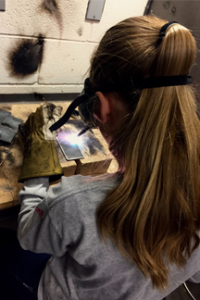
- Independent Living Assessments
- Employment Readiness Assessments
- College to Career Assessments
- Links Only
 Community Transition Program: Experiences Starting a Community-Based Program for Students Ages 18-21
Community Transition Program: Experiences Starting a Community-Based Program for Students Ages 18-21
The Transition Coalition’s Community Transition Program: Experiences Starting a Community-Based Program for Students Ages 18 through 21 has several resources for supporting independent living for students with disabilities, such as:
Community Transition Objectives (pages 41 to 46) is an inventory/checklist of skills that could be considered when assessing a student’s needs and strengths regarding independent living skills. The inventory assesses things like personal finance, planning, organizing, scheduling, grooming, self-care, household management, and more.
C-Tran Functional Analysis of Behavior (pages 75 through 83) concerns a battery of independent living scenarios that includes the morning routine, arranging and using public transportation, arrival at work, the social skills needed for work, going to the bank, going to the grocery store, meal preparation, and more.
A Day in the Life at C-Tran: A Test of One’s Abilities to Problem Solve, (checklist on page 33), provides a number of potential day-to-day stress or crisis situations of varying degrees that, with slight modifications as necessary/appropriate, can be discussed with students in a formal or informal manner to gauge problem-solving skills in regards to readiness for independent living.
Important Prerequisites for Independent Community Involvement (page 41) is a short checklist exploring various scenarios necessary for successful community involvement. This checklist could be used as a starting point for assessment or discussion with students regarding their knowledge and acceptance of expected skills and behaviors, including assuming some responsibility for personal items/money, social skills, using a telephone, wearing clean clothes every day, and more.
Independent Living Skills Measurement Scale
The Independent Living Skills Measurement Scale is a simple 14-question survey parents or staff can use to rate a student’s independent living skills on a variety of topics, including medication usage, grooming and hygiene, laundry, household responsibilities, setting limits on his/her own behavior, and more. This assessment also includes a chart with a visual representation of the student’s skills and improvement areas. The measurement scale was created by Edward Flegel, formerly a transition consultant for Ohio’s State Support Team 3.
Independent Living Skills Toolkit
Produced by the Ohio Department of Job and Family Services, the Independent Living Skills Toolkit was primarily designed for foster youth ages 14 and up; however, the independent living scenarios and considerations discussed in this booklet can serve as a guide for conversations and potential age-appropriate transition assessments for all transition-age youth. The topics include Academic Support, Post-Secondary Education Support, Career Preparation, Employment Programs and Vocational Training, Budget and Financial Management, and Health Education and Risk Prevention, Family Support and Healthy Marriage Education, and more.
PEATC Life Skills Checklist
The PEATC Life Skills Checklist was created by the Parent Educational Advocacy Training Center (Virginia) and identifies a number of independent living skills students need for successful independent living. Categories include: personal life skills, emergency / safety skills, nutrition / dietary skills, money management / financial planning skills, and others on a scale ranging from “can do already” to “ongoing support needed.” While individual life skill needs per student will vary, this interactive checklist provides many areas of discussion and focus for parents, teachers, and students alike.
Banzai.org
Banzai.org is a free interactive educational platform offers activities and modules that teach and allow assessment of real-world finance and other practical life skills. Some of the items under the “Resources” tab ( such as the various finance-focused calculators) require no account creation/log-in, while the courses do require a free account creation/log-in for the teacher and students to get full access to them.
This page was updated November 12, 2021
 123 Test (Picture-Based Employment Preference)
123 Test (Picture-Based Employment Preference)
Created by 123test, a Netherlands-based company located at the Radboud University Nijmegen in the Netherlands, the Career Aptitude Test is a picture-based career test presents fifteen sets of four pictures that show specific work activities. Students select the photo of a work activity that appeals the most, and the one that appeals the least. Upon completion, suggestions for professions are given based on a characterization of personality in terms of Holland Code personality types to learn what kind of work environments and occupations may suit the student best.
Bureau of Labor Statistics Occupational Outlook Handbook
Available from the U.S. Bureau of Labor Statistics, the Outlook Handbook can help students find career information on duties, education and training, pay, and outlook for hundreds of occupations across the country.
Employability/Life Skills Assessment (ELSA)
Through the Ohio Center for Autism and Low Incidence, the Ohio Employability/Life Skills Assessment (ELSA) is for teachers and families. Employability skills, personal social behaviors, and daily living habits are life skills that must be taught with the same rigor as basic skills. The development of such skills is a lifelong process, with performance being relative to a student’s ability and age. Teachers at all age levels have the responsibility to teach these skills. ELSA is a frequently-used assessment tool for students whose skills for employment should be measured when developing IEP goals and Transition Plans.
OCTOBER 2020 UPDATE: There are now slightly updated versions of both the Transition Team Professionals and Formatted for Families versions, making them fillable and downloadable PDFs. There is some updated language, and the age ranges are now fillable, but the categories remain the same.
Employment Related Questions
Originally from the National Secondary Transition Technical Assessment Center (NSTTAC), and available from the University of North Carolina at Charlotte, Employment Related Questions is a basic introductory survey that can be given to students to help them learn about their current and future employment considerations and goals.
The Environmental Job Assessment Measure: E-JAM
Developed by the Transition Coalition, the Environmental Job Assessment Measure: E-JAM has been used extensively with adolescents with emotional disturbances or disabilities and those with high-risk behaviors. E-JAM was designed to assist in determining an employment placement and the support and accommodations that might be needed. The survey allows a teacher to evaluate and document a student’s general work behaviors and attitudes, accommodations and modifications, and supports based on the expected physical, educational, and social demands of the job or workplace location in question. The additional materials link provides other transition-based pamphlets and such that could be distributed.
Explore Work
Explore Work is a website that contains activities and resources that enable students to find out more about who they are and what they’re good at in regards to preparing for the world of work. Areas of focus include discovering talents and jobs that may be a good fit, getting experiences to try out jobs, uncovering education and training options to help them meet job goals, learn about self-advocacy, and more.
 Holland Occupational Themes/RIASEC Inventory
Holland Occupational Themes/RIASEC Inventory
Developed by JIST Publishing, the Holland Occupational Themes is a theory of personality that focuses on career and vocational choice. It groups people on the basis of their suitability for six different categories of occupations. The six types yield the RIASEC acronym, by which the theory is also commonly known. The assessment consists of 48 example tasks that students will rate on a scale 1-5, then provides occupation information to explore based on their answers. The assessment takes most students five to 10 minutes to complete.
Job Site Analysis Survey
Developed by the Transition Community Network through the Oregon Department of Education, the Job Site Analysis Survey allows teachers, students, families, and employers to evaluate a current or potential job site by its physical demands, social characteristics/atmosphere, environmental characteristics, and natural supports. This is a very good tool to use when discussing specific employment possibilities with students.
Photo Career Quiz
Created by Truity Psychometrics, LLC, in San Francisco, California, Photo Career Quiz is a photo-based assessment that measures career interests in six key areas as described by Dr. John Holland: Building, Thinking, Creating, Helping, Persuading, and Organizing. Users will learn their career type, which is based on their highest interest area, as well as their scores in the remaining five interest areas. The average time to take the assessment is five minutes.
Preference Indicators
The Zarrow Center for Learning Enrichment at the University of Oklahoma in cooperation with Dr. Valerie N. Williams, Director of the Center for Learning and Leadership and Associate Vice Provost has provided three resource surveys to determine student interest:
These tools can be used by the student, parent, educator, or even employer to help determine student preference.
Unpaid Work Experiences, Volunteering & Internships
Volunteering, Internships, and Unpaid Work Experiences: Legal and Practical Guidelines from Ohio Employment First does not contain assessments, but provides guidelines on the role of volunteer activities, internships, and unpaid work when assisting and supporting individuals with disabilities. This information is based on interpretation of various federal and state requirements. Questions regarding specific situations should be directed to the United States Department of Labor (DOL) Wage and Hour Division and/or the Ohio Department of Labor to ensure compliance with all applicable labor laws and regulations.
Task Analysis for Maintaining Work Area
Originally from the National Secondary Transition Technical Assessment Center (NSTTAC), and available from the University of North Carolina at Charlotte, the Task Analysis for Maintaining Work Area is a simple task-analysis chart that may be used to monitor and document a student’s ability to maintain their work area and schedule based on seven criteria. This is a good tool to use for documentation purposes when evaluating students who have classroom or school-based jobs.
Virginia Career VIEW (Students Grade K-8)
Virginia Career VIEW (Vital Information for Education and Work) is a colorful, interactive website that offers students, families, and professionals resources for career exploration, transition assessments, goal setting, and more for students Grades K-8. The site also offers ideas for incorporating transition planning, awareness, and exploration with students. Also included are numerous paper, web, and game-based assessments and information, including a section on unusual occupations that includes realistic details on what it takes to be a video game designer, work for NASCAR, become a forensic crime scene investigator, etc. Recognized as the Commonwealth’s Career Information Delivery System for all students in grades K-8 in Virginia, VA, Career VIEW is included as part of the College of Liberal Arts and Human Sciences in the School of Education Virginia Tech University.
This page was updated January 26, 2021
 Access to Success: A Free Online Training for College Students with Disabilities
Access to Success: A Free Online Training for College Students with Disabilities
Created by the University of Kansas Research and Training Center on Independent Living (RTC/IL) and funded by the National Institute on Disability and Rehabilitation Research, Access to Success is an online module-based website (with an automatic read-aloud feature) that discusses (and asks reflective questions about) topics for students with disabilities who are considering going to college, including a pre-assessment warm-up, rights of students in college, and how to ask for accommodations.
College Applicant Rating Scale & Benchmarks of Effective Supports for Students with Autism Spectrum Disorders
Developed by the West Virginia Autism Training Center at Marshall University, the College Program for Students with Autism Spectrum Disorder Applicant Evaluation is an assessment for staff in which the student is rated on a scale of 1-5 concerning a number of areas pertinent to success in a college atmosphere, including Academics, Independent Living, Socialization, Safety, Sexuality, Stress and Personal Insight. Again, while this tool was specifically designed for students with ASD, it could prove useful for pre-college assessment on various students with various disabilities.
Along with the evaluation is the Benchmarks of Effective Supports for College Students with Autism Spectrum Disorders checklist is an assessment tool with which can be used to determine the readiness of specific institutions of higher learning in regards to their support for students with disabilities in the areas of campus living supports, academic supports, and non-academic supports.
Editor’s Note: While specifically designed for students with Autism Spectrum Disorders (ASD), these tools could be used by students with other disabilities in regards to assessing the supports needed to attend college.
College Board
The College Board developed Services for Students with Disabilities, Ensuring Accommodations on College Board Exams, a document that provides information for students with disabilities about accommodations they need to take the SAT, SAT Subject Tests, PSAT/NMSQT, and Advanced Placement Exams.
College Planning for Students with Disabilities
Available from Best Colleges, College Planning for Students with Disabilities is a guide that explains a college or prospective college student’s legal rights as a person with disabilities and discusses campus resources that may provide them with assistive services and tools. This webpage also lists a number of additional sites, apps, and software resources designed to aid students with specific types of disabilities, including learning disabilities, ADHD, dyslexia, visual impairments, deaf and hard of hearing, autism spectrum disorders, physical disabilities, and more.
College Results Online
Developed by The Education Trust, College Results Online is an interactive, user-friendly web-based tool designed to provide policymakers, counselors, families, students, and others with information about college graduation rates for nearly any four-year college or university in the country. It allows students to search colleges by name, then compare graduation rates, cost, average test scores for admission, and more. This site can be used by students considering college to help ascertain the financial and academic resources they will need in order to help maximize their admittance and their success potential.
Going to College: A Resource for Students with Disabilities
Available from Virginia Commonwealth University, Going to College: A Resource for Students with Disabilities is a website containing a variety of tools that can be used by students and teachers for students with disabilities expressing an interest in going to college. Activities and assessments are broken into categories including “My Place (self-assessments), “Campus Life,” “Planning for College,” and “My Portfolio.” The Teacher’s Toolbox button contains ways to integrate some of the activities into classroom lessons.
Guide to Assessing College Readiness
Available from the Transition Coalition, Landmark College identified five essential foundations that are necessary for students with learning disabilities and AD/HD to be successful in college. A Guide to Assessing College Readiness assessment looks at these foundations which are academic skills, self-understanding, self-advocacy, executive function, and motivation and confidence. This assessment uses a checklist format to identify student strengths and needs.
Making My Way Through College
Developed by National Collaborative on Workforce and Disability/Youth, Making My Way through College is a 44-page guide meant for any student pursuing a degree or other type of credential (e.g., certification, license) at a two-year or four-year community college, college, or university. You will find information on a variety of topics relevant to preparing for and succeeding in college and transitioning from college into the world of work. Much of the information provided is relevant to all students, but the primary focus of the guide is on navigating the college experience for students with disabilities or those who think they may have a disability, including several checklists of topics for consideration.
Ohio Transfer to Degree Guarantee (T2DG)
Developed by the Ohio Board of Regents University System of Ohio, the Ohio Transfer to Degree Guarantee or T2DG program enables Ohio students to streamline credit transfer among the state’s public institutions of higher education and from adult/secondary career-technical institutions to find the best pathways to degree completion and launch successful careers.T2DG helps students meet general education requirements, requirements in 60+ career-oriented programs when transferring equivalent coursework, and encompasses courses and programs offered by Ohio public institutions of higher education and adult and secondary public career-technical institutions. T2DG also includes Advanced Placement and military training and experience.
Postsecondary Readiness Rubric v. 4
Developed by ThinkCollege, the Postsecondary Readiness Rubric v. 4 can be used by students, parents, school counselors, and teachers to help a student to determine performance of critical skills needed to succeed in a postsecondary setting such as a career school, community college, or university.
Secondary School Success Checklist (Autism Spectrum Disorders)
Created by University of North Carolina at Chapel Hill, the Secondary School Success Checklist was designed to be used with students who have Autism Spectrum Disorders. It is intended to be completed with information from the student, school staff, and the student’s family. The checklist covers the domains of responsibility and independence, community engagement, and self-management. It not only allows each skill to be evaluated, but also has a section to identify the priority level of each skill.
Set to Go: Preparing High School Students for College & Life
Developed by the Jed Foundation (JED), Set to Go is a program to help high school students prepare for the transition to college and to life after high school. Research with first-year college students shows most wish they were better emotionally prepared for the transition from high school to college. Emotional preparedness for life after high school involves five key areas of knowledge and skill development. The program provides a wealth of information about putting college in perspective, basic life skills, social and emotional skills, mental health and substance abuse literacy, and the transition to college life.
Step-by-Step: College Awareness and Planning for Families, Counselors and Communities
Created by the National Association for College Admission Counseling (NACAC) and revised in 2017, Step-by-Step Curriculum is presented in four grade-level sections and offers training for counselors and others who work with underrepresented and under-served students to provide comprehensive tools for meeting the needs of first-generation college students and their families.
Transition of Students with Disabilities to Postsecondary Education: A Guide for High School Educators
Available from the U.S. Department of Education, Office for Civil Rights, Transition of Students with Disabilities to Postsecondary Education: A Guide for High School Educators is geared towards sharing information with teachers concerning what students with disabilities can and should expect when transitioning to college. Along with some detailed front page information (which can also be requested in booklet form), several live links lead to further information concerning this ever-evolving topic, and it may all serve as a gateway to discussing college with students and parents who show an interest in postsecondary education/college.
This page was updated November 1, 2021
- 123 Test (Picture-Based Employment Preference)
- Access to Success: Online Training for College Students with Disabilities
- The Art of Active Listening: Career-Centered Active Listening Game

- Benchmarks of Effective Supports for College Students with Autism Spectrum Disorders
- Bureau of Labor Statistics Occupational Outlook Handbook
- College Planning for Students with Disabilities
- College Program for Students with Autism Spectrum Disorder Applicant Evaluation
- College Results Online
- Community Transition Program: Experiences Starting a Community-Based Program for Students Ages 18 through 21
- E-JAM Survey
- Employment-related Questions
- Explore Work
- Going to College: A Resource for Students with Disabilities
- Guide to Assessing College Readiness
- Holland Occupational Themes
- Independent Living Skills Measurement Scale
- Job Site Analysis Survey
- Making My Way through College
- Ohio Employability/Life Skills Assessments (ELSA)
- Ohio Transfer to Degree Guarantee or T2DG
- Preference Indicator Surveys
- Photo Career Quiz
- Postsecondary Readiness Rubric v. 4
- Secondary School Success Checklist
- Services for Students with Disabilities, Ensuring Accommodations on College Board Exams
- Set to Go
- Step by Step: College Awareness and Planning for Families, Counselors and Communities
- Task Analysis for Maintaining Work Area
- Transition of Students with Disabilities to Postsecondary Education: A Guide for High School Educators
- Unpaid Work Experiences, Volunteering, and Internships
- Virginia Career VIEW (Vital Information for Education and Work
is page was updated November 1, 2021

